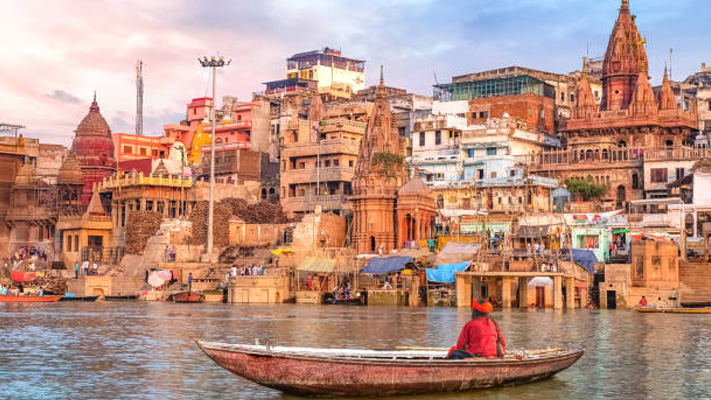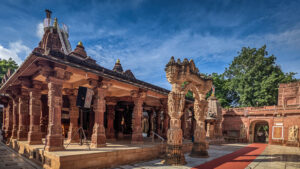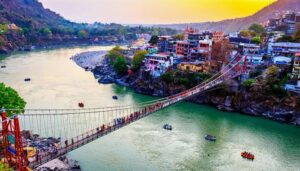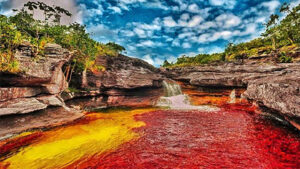10 FAMOUS GHATS OF VARANASI – AN ABODE FOR A SOUL LIBERATING EXPERIENCE

Varanasi, also known as Banaras or Kashi, is a city in northern India situated on the banks of the sacred river Ganges. It is a popular tourist destination and one of the oldest continuously inhabited cities in the world. Here are some factors that make Varanasi a great tourist destination:
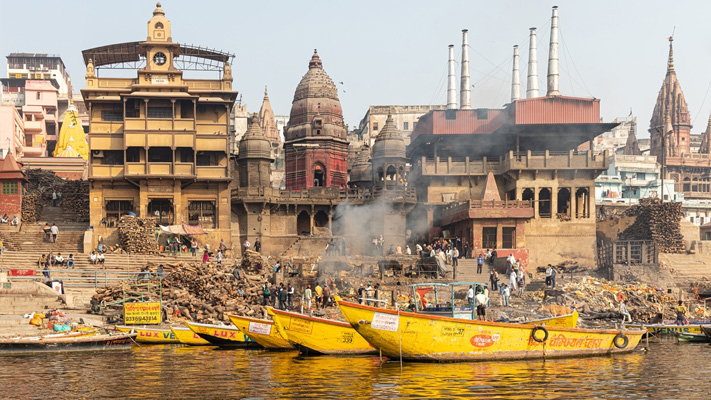
- Cultural and Religious Significance: Varanasi is considered to be one of the most important religious and cultural centres in India. The city is known for its numerous temples, ghats (steps leading down to the river), and holy sites. Visitors can witness daily rituals, ceremonies, and prayers at the ghats, which are a unique and memorable experience.
- History and Heritage: Varanasi has a rich history and cultural heritage, dating back thousands of years. Visitors can explore its numerous historical and cultural landmarks, such as the Kashi Vishwanath Temple, the Sarnath Archaeological Site, and the Ramnagar Fort and Museum.
- Traditional Crafts and Cuisine: Varanasi is known for its traditional crafts, such as silk weaving and brass work, which are unique to the region. The city is also known for its delicious cuisine, which includes a range of vegetarian dishes and sweets that are unique to the region.
- Spiritual and Wellness Retreat: Many visitors come to Varanasi to experience its spiritual and wellness offerings, such as yoga and meditation classes, Ayurvedic treatments, and spiritual retreats, which makes it an ideal destination for those seeking relaxation and rejuvenation.
Varanasi is famous for its ghats, which are a series of steps leading down to the banks of the Ganges river. Here are the 10 most famous ghats of Varanasi:
1. Dashashwamedh Ghat
Dashashwamedh Ghat is one of the most famous and important ghats in Varanasi, India. It is located on the banks of the river Ganges and is known for its spectacular evening aarti ceremony and bustling atmosphere. Here’s a brief history of Dashashwamedh Ghat and why it is special:
History: The ghat was built in the 18th century by the Maratha ruler, Baji Rao I, and is named after the ten horses that were sacrificed during a ritual performed by Lord Brahma to welcome Lord Shiva. Legend has it that Lord Brahma created this ghat to welcome Lord Shiva to Earth and offer him the throne of the city.
Significance: Dashashwamedh Ghat is considered to be one of the holiest and most significant ghats in Varanasi. The ghat is believed to be the spot where Lord Brahma performed the famous Dasha Ashwamedh Yajna (a ten-horse sacrifice), and it is said that Lord Shiva himself appeared at the ghat to accept the sacrifice. The ghat is also believed to be the spot where Lord Buddha gave his first sermon after attaining enlightenment.
The Evening Aarti: One of the main attractions of Dashashwamedh Ghat is the evening aarti ceremony, which takes place every day at sunset. The aarti is a Hindu ritual of worship, in which offerings are made to the gods using fire, water, flowers, and other items. The aarti at Dashashwamedh Ghat is a grand and spectacular affair, with numerous priests performing the ritual simultaneously, and the whole ghat lit up with lamps and candles. Thousands of devotees and tourists gather to witness the aarti and offer prayers to the gods.
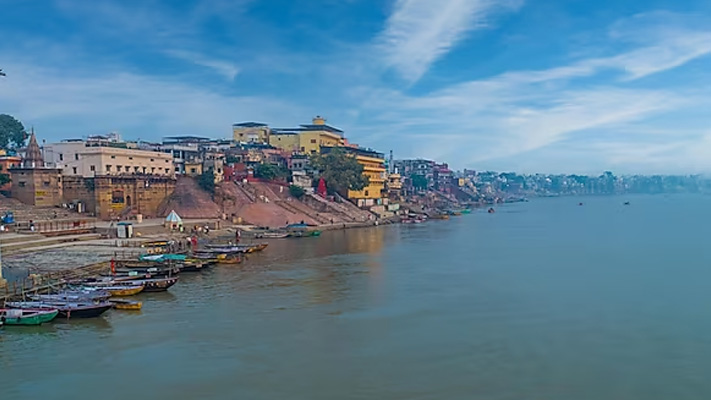
2. Manikarnika Ghat
Manikarnika Ghat is one of the oldest and most sacred ghats in Varanasi, India. It is considered to be the primary cremation ground for Hindus, and it is believed that those who are cremated at this ghat achieve moksha or liberation from the cycle of birth and death. Here’s a brief history of Manikarnika Ghat and why it is special:
History: Manikarnika Ghat is said to have been created by Lord Vishnu when he dug a well with his discus, known as the Sudarshana Chakra. The ghat is also associated with the goddess Parvati, who is believed to have dropped her earrings (manikarnika) into the well while bathing. The ghat is also believed to be the spot where Lord Shiva brought the dead body of his wife Sati, and where she was later cremated.
Significance: Manikarnika Ghat is one of the holiest and most significant ghats in Varanasi. It is believed that those who are cremated at this ghat achieve moksha, and it is considered to be a great honor to be cremated here. The ghat is always busy with funeral processions and the sounds of the funeral pyres burning can be heard day and night.
The rituals performed at Manikarnika Ghat are an important part of Hindu customs and beliefs. It is believed that the soul of the departed person is released from the body through the cremation process and goes on to the next life. The ashes are then immersed in the holy river Ganges to complete the cycle.
The ghat is also significant because of the Manikarnika Kund, a small pond located near the ghat. It is believed that the pond was created by Lord Vishnu and is a sacred spot for taking a dip and offering prayers.
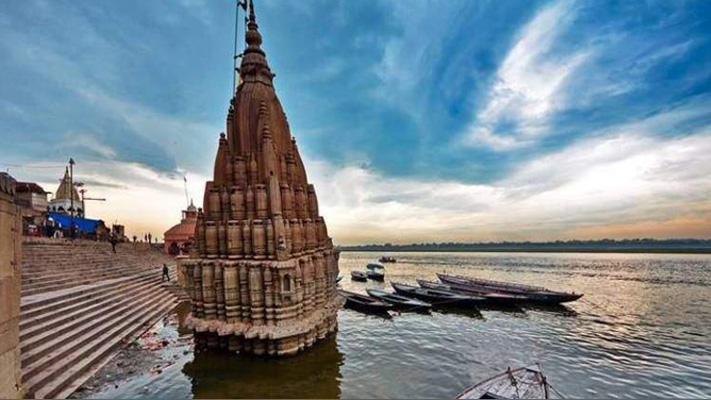
3. Assi Ghat
Assi Ghat is a famous and popular ghat located at the confluence of the river Ganges and the Assi river in Varanasi, India. Here’s a brief history of Assi Ghat and why it is special:
History: According to Hindu mythology, Lord Shiva came to the Assi river after slaying the demon Shumbha-Nishumbha. It is believed that Lord Shiva bathed in the river to cleanse himself and the ghat was later constructed in his honor. Assi Ghat is also mentioned in the scriptures as the place where the famous sage, Agastya, meditated and Lord Rama took a dip in the river.
Significance: Assi Ghat is a significant destination for pilgrims and tourists alike. It is believed that taking a dip in the waters of the Ganges at this ghat washes away one’s sins and helps in attaining moksha or liberation. The ghat is also known for its spectacular sunrise and sunset views over the river Ganges.
Assi Ghat is also known for its lively and colorful atmosphere. The ghat is lined with shops selling religious items, souvenirs, and street food. The ghat also hosts several cultural events and festivals throughout the year, including the Ganga Mahotsav and the Kumbh Mela.
Another unique feature of Assi Ghat is the Aghor Ashram located nearby. The Aghori sadhus, known for their extreme and unconventional practices, are a common sight around the ghat. Visitors can interact with them and learn about their way of life and beliefs.
4. Harishchandra Ghat
Harishchandra Ghat is a famous ghat located on the banks of the river Ganges in Varanasi, India. Here’s a brief history of Harishchandra Ghat and why it is special:
History: Harishchandra Ghat is named after the mythological king Harishchandra, who is known for his dedication to truth and honesty. According to Hindu mythology, the king lost his kingdom and his family due to his unwavering commitment to truth. It is said that he came to this ghat to work as a caretaker of the cremation ground and it was here that he faced numerous trials and tribulations. He is considered to be a symbol of sacrifice and selflessness.
Significance: Harishchandra Ghat is one of the oldest and most sacred ghats in Varanasi. It is primarily a cremation ground and is considered to be one of the most important places for performing the last rites for the deceased. The ghat is always busy with funeral processions, and the sound of the funeral pyres burning can be heard day and night.
It is believed that performing the last rites at Harishchandra Ghat helps in achieving moksha or liberation from the cycle of birth and death. The ghat is also significant because it is believed to be the spot where Lord Rama, the seventh incarnation of Lord Vishnu, arrived after defeating the demon king Ravana in the epic Ramayana.
Harishchandra Ghat is also known for its association with the poet Tulsidas, who is famous for his epic poem “Ramcharitmanas”. It is believed that Tulsidas wrote this poem on the steps of this ghat while he was living in Varanasi.
5. Kedar Ghat
Kedar Ghat is a prominent ghat located on the banks of the river Ganges in Varanasi, India. Here’s a brief history of Kedar Ghat and why it is special:
History: Kedar Ghat is named after the Kedareshwar Temple, which is located nearby. The temple is dedicated to Lord Shiva, who is also known as Kedareshwar. According to Hindu mythology, it is believed that Lord Shiva himself established the lingam, a symbol of his divine presence, at this spot.
Significance: Kedar Ghat is considered to be one of the most sacred ghats in Varanasi. It is known for its association with Lord Shiva and the Kedareshwar Temple, which is visited by devotees throughout the year. The ghat is also famous for its magnificent architecture, which includes several shrines, temples, and ashrams.
The ghat is a popular spot for performing various rituals and ceremonies, such as the Mundan ceremony (a ritualistic head-shaving ceremony) and the Ganga Aarti, a daily ritual performed at sunset, where lamps are lit and prayers are offered to the river Ganges.
Kedar Ghat is also a great place for boat rides on the river Ganges. Visitors can hire boats to take a ride along the river and enjoy the scenic views of the ghat and the surrounding areas. The ghat is also surrounded by several other important temples, such as the Kashi Vishwanath Temple and the Annapurna Temple.
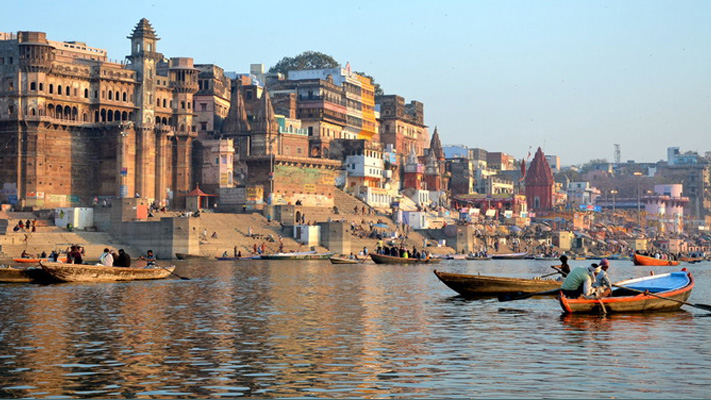
6. Scindia Ghat
Scindia Ghat is a historic ghat located on the banks of the river Ganges in Varanasi, India. Here’s a brief history of Scindia Ghat and why it is special:
History: Scindia Ghat was built by the Scindia family, who were rulers of the Gwalior state in the 19th century. The ghat was constructed to facilitate the transportation of goods and people across the river Ganges. The Scindia family was known for their patronage of the arts and literature, and they built several temples, palaces, and monuments in Varanasi.
Significance: Scindia Ghat is one of the most beautiful and peaceful ghats in Varanasi. It is known for its stunning architecture, which includes several palaces, temples, and buildings. The ghat is also famous for its association with the Scindia family, who played an important role in the development of Varanasi.
One of the most notable landmarks at Scindia Ghat is the Shri Shiva Kashi Vishwanath Temple, which is dedicated to Lord Shiva. The temple is believed to be one of the twelve Jyotirlingas, which are considered to be the holiest shrines of Lord Shiva. The temple is a popular destination for pilgrims and tourists, who come to offer prayers and seek blessings.
Scindia Ghat is also famous for its association with music and dance. It is home to several music and dance schools, where students learn traditional Indian music and dance forms. Visitors can often witness impromptu musical performances and dance recitals on the ghat, which adds to the cultural charm of the place.
7. Tulsi Ghat
Tulsi Ghat is one of the many ghats located on the banks of the river Ganges in Varanasi, India. Here is a brief overview of Tulsi Ghat and its significance:
History: Tulsi Ghat is named after the famous Indian poet and philosopher, Tulsidas. Tulsidas is known for his work Ramcharitmanas, an epic poem that retells the story of Lord Rama in Hindi. Tulsi Ghat is believed to be the place where Tulsidas wrote the final verses of the Ramcharitmanas. The ghat was built in the 16th century and has undergone several renovations over the years.
Significance: Tulsi Ghat is an important destination for pilgrims and tourists visiting Varanasi. It is believed that taking a dip in the holy waters of the river Ganges at Tulsi Ghat can wash away one’s sins and bring spiritual enlightenment. The ghat is also known for its association with Tulsidas and his literary works. Many devotees visit Tulsi Ghat to pay their respects to the poet and seek blessings.
Tulsi Ghat is also famous for its cultural significance. It is home to several music and dance schools, where students learn traditional Indian music and dance forms. Visitors can often witness impromptu musical performances and dance recitals on the ghat, which adds to the cultural charm of the place.
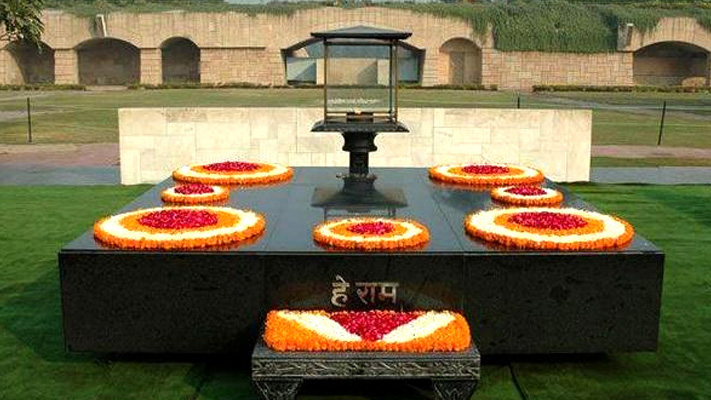
8. Panchganga Ghat
Panchganga Ghat is one of the oldest and most sacred ghats located on the banks of the river Ganges in Varanasi, India. Here is a brief overview of Panchganga Ghat and its significance:
History: According to Hindu mythology, Lord Vishnu is believed to have created the Panchganga Ghat by merging the five sacred rivers of India – Ganges, Yamuna, Saraswati, Kirana, and Dhupapapa – at this spot. The ghat was built in the 16th century and has undergone several renovations over the years.
Significance: Panchganga Ghat is an important destination for pilgrims and tourists visiting Varanasi. It is believed that taking a dip in the holy waters of the river Ganges at Panchganga Ghat can wash away one’s sins and bring spiritual enlightenment. The ghat is also known for its association with Lord Vishnu and his creation of the Panchganga.
The ghat is also famous for its cultural significance. It is home to several temples, including the Kashi Vishwanath Temple, which is dedicated to Lord Shiva. The temple is one of the most important shrines for Hindus and attracts thousands of devotees every year.
Panchganga Ghat is also a popular spot for boat rides and offers a spectacular view of the sunrise and sunset over the river Ganges. Visitors can take a boat ride along the river and witness the vibrant and bustling life of Varanasi along the ghats.
9. Hanuman Ghat
Hanuman Ghat is one of the many ghats located on the banks of the river Ganges in the holy city of Varanasi, India. Here is a brief overview of Hanuman Ghat and its significance:
History: The Hanuman Ghat is believed to have been built by the Maratha ruler, Maharaja Balaji Baji Rao, in the 18th century. It is named after Lord Hanuman, who is one of the most revered deities in Hindu mythology.
Significance: Hanuman Ghat is a popular destination for tourists and pilgrims visiting Varanasi. The ghat is known for its beautiful architecture and the stunning views it offers of the river Ganges. It is also home to several temples, including the Kashi Vishwanath Temple, which is dedicated to Lord Shiva. The temple is one of the most important shrines for Hindus and attracts thousands of devotees every year.
Hanuman Ghat is also famous for its association with the Ramayana, one of the most important epics in Hindu mythology. According to legend, Lord Hanuman was a devotee of Lord Rama and played a key role in his battle against the demon king Ravana. It is believed that Lord Hanuman visited Varanasi and stayed at the Hanuman Ghat during his travels.
In addition to its religious and cultural significance, Hanuman Ghat is also a popular spot for boat rides along the river Ganges. Visitors can take a boat ride and witness the vibrant and bustling life of Varanasi along the ghats.
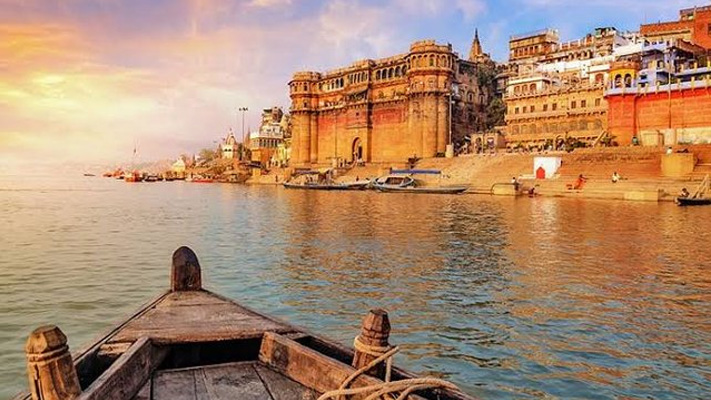
10. Raj Ghat
Raj Ghat is a memorial to Mahatma Gandhi, the Father of the Nation, located on the banks of the river Yamuna in Delhi, India. Here is a brief overview of Raj Ghat and its significance:
History: Raj Ghat was built in 1951, a year after the assassination of Mahatma Gandhi. The memorial was designed by architect Vanu G. Bhuta and is a simple black marble platform with an eternal flame, surrounded by a beautiful garden.
Significance: Raj Ghat is an important site for tourists and pilgrims visiting Delhi. The memorial is a symbol of the life and legacy of Mahatma Gandhi, who was a political and spiritual leader in India’s freedom struggle. Gandhi’s philosophy of non-violent resistance or “Satyagraha” inspired movements for civil rights and freedom across the world.
Raj Ghat is a peaceful and serene place where visitors can pay their respects to Gandhi and reflect on his teachings. The eternal flame at the center of the memorial symbolizes the spirit of Gandhi and the hope for a better future. The garden surrounding the memorial is well-maintained and adds to the peaceful ambiance of the place.
The memorial is open to visitors throughout the year, and many important national events are held here, including the annual Gandhi Jayanti celebrations on 2nd October, the birth anniversary of Mahatma Gandhi.



